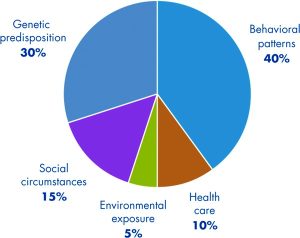
 Definition: Years of potential life lost before age 75 per 100,000 population at one-year estimate.
Definition: Years of potential life lost before age 75 per 100,000 population at one-year estimate.
Premature death is a measure of years of potential life lost due to death occurring before the age of 75.
Deaths at younger ages contribute more to the premature death rate than deaths occurring closer to age 75.
For example, a person dying at age 70 would lose five years of potential life, whereas a child dying at age five would lose 70 years of potential life.
Years of Potential Life Lost (YPLL) Report: cancer, unintentional injury, heart disease, suicide, deaths in the perinatal period and homicide were the leading causes of years of potential life lost before age 75 in 2019.
Since 2000, increases have occurred in suicide and drug deaths, both contributing to the rise in premature death.
Many premature deaths may be preventable through lifestyle modifications such as smoking cessation or healthy eating and exercise.
Passive smoke associated with an increased risk of death in both adults, where it is estimated to kill 53,000 nonsmokers per year, making it the third leading cause of preventable death in the U.S, and in children.
The Centers for Disease Control and Prevention (CDC) estimate that 20-40% of premature deaths are preventable.
Risk factors for premature death include obesity, smoking and exposure to environmental hazards such as reduced air quality.
Risk factors for heart disease, such as high blood pressure, high cholesterol, Type 2 diabetes and physical inactivity are also risk factors for premature death.
Occupational hazards and certain behaviors, including not wearing seatbelts or motorcycle helmets and misusing drugs can increase the risk of unintentional injuries and premature death.
Social factors such as low education, poverty, racial segregation and inadequate social support also contribute to premature death.
Social factors can play a role in how and why a person dies.
Populations at higher risk for premature death include:
American Indian/Alaska Native populations: have premature death rates persistently 50% greater than those of non-Hispanic whites.
Infant mortality rates are almost two times higher among American Indian/Alaska Natives than non-Hispanic whites and are a major contributor to premature deaths.
Risk factors contributing to a higher rate of unintentional injuries among American Indian/Alaska Natives include rural environments, lack of traffic safety and higher rates of alcohol-related accidents.
Black individuals had a premature mortality rate double that of white individuals from 1960 through 2009.
Racial disparities in cardiovascular disease and homicide have long been the leading drivers of higher rates of premature mortality, as well persistent gaps in birth outcomes.
Black populations have the highest infant mortality rates, more than twice those of white and Asian populations.
People who live in rural counties compared with urban counties.
Black adults in rural counties have the highest mortality rate; however, white adults in rural areas had the largest increase in mortality rates: largely due to increased poisonings, including drug overdoses and suicides.
Lifestyle changes can help prevent premature deaths: changes in diet, exercise, alcohol consumption and tobacco use, as well as medical treatment for chronic conditions such as depression, diabetes or hypertension.
WHO suggest that individuals can meet recommended levels of physical activity have a 20 to 30% reduce risk of premature death

One reply on “Premature death”
Hi standardofcare.com owner, Great content!